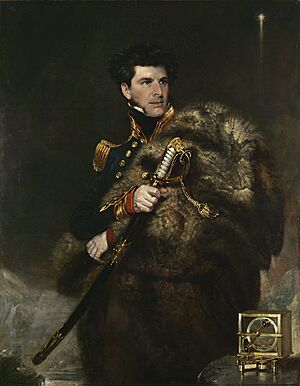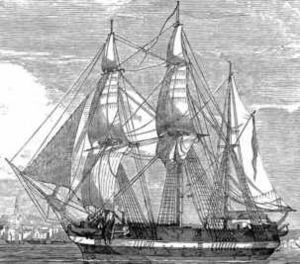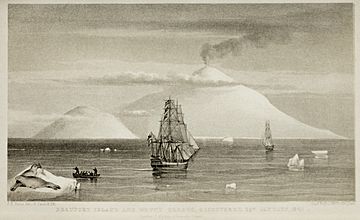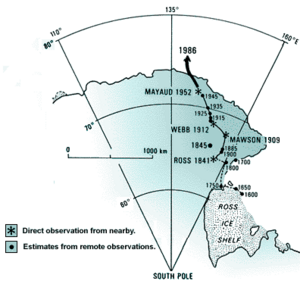Ross expedition facts for kids
The Ross expedition was an amazing journey of scientific exploration to the Antarctic between 1839 and 1843. It was led by James Clark Ross using two extra-strong ships, HMS Erebus and HMS Terror. During this trip, they explored what is now known as the Ross Sea and found the huge Ross Ice Shelf. Ross also discovered the Transantarctic Mountains and two volcanoes, Mount Erebus and Mount Terror, which he named after his ships. A young plant expert named Joseph Dalton Hooker became famous because of his work on this expedition.
The expedition proved that the continent of Antarctica really existed. They also figured out where the South Magnetic Pole was. The team made many important notes about the animals (zoology) and plants (botany) of the area. This led to a big book about the animals and four detailed books by Hooker about the plants, called Flora Antarctica. These books were published over many years. One of the new animals they found was the Ross seal, which lives only in the icy areas of Antarctica. This expedition was also the last big exploration trip done completely by sailing ships.
Contents
The Expedition's Journey

Why the Expedition Happened
In 1838, a group called the British Science Association suggested a trip to measure the Earth's magnetism in Antarctica. Sir James Clark Ross was chosen to lead it. He had a lot of experience from working on magnetic surveys since 1834. Ross had also been on many trips to the Arctic before, so he was a skilled captain.
The People on Board
Ross, a captain in the Royal Navy, was in charge of HMS Erebus. His good friend, Captain Francis Crozier, commanded the other ship, HMS Terror.
Joseph Dalton Hooker, a plant expert, was only 23 years old and the youngest person on the trip. He was an assistant doctor to Robert McCormick. Hooker's job was to collect animal (zoological) and rock (geological) samples. He later became one of England's most famous plant experts. He was also a close friend of Charles Darwin and led the Royal Botanical Gardens, Kew for 20 years.
Another important person was John E. Davis, the second master on Terror. He was responsible for making many maps and drawings of the journey.
The Ships: Erebus and Terror

HMS Erebus and HMS Terror were very strong warships. They were built as bomb ships, which meant they were designed to fire heavy bombs. Because of this, they were built extra tough to handle the powerful kickback of these weapons. Their strong build made them perfect for sailing through dangerous sea ice that could crush other ships. The Erebus weighed 372 tons and had two large mortars and ten guns.
The Voyage Itself

In September 1839, Erebus and Terror left Chatham Dockyard in England. They arrived in Tasmania (then called Van Diemen's Land) in August 1840. On November 21, 1840, they set off for Antarctica. In January 1841, the ships landed on Victoria Land. They named different places after British politicians, scientists, and friends. Mount Erebus, on Ross Island, was named after one ship, and Mount Terror after the other. McMurdo Sound was named after Archibald McMurdo, a senior officer on Terror.
On January 28, 1841, they reached 76° south latitude. The explorers saw: A low white line that stretched as far as they could see. It looked amazing, getting taller as they got closer. It turned out to be a straight ice cliff, about 150 to 200 feet (45 to 60 meters) high above the sea. The top was perfectly flat, and the front facing the sea was smooth.
Ross called this the "Great Ice Barrier." Today, it's known as the Ross Ice Shelf. They couldn't get through it, so they followed it eastward. But because it was getting late in the season, they had to go back to Tasmania. The next summer, in 1841–42, Ross kept following the ice shelf eastward. Both ships stayed in Port Louis in the Falkland Islands for the winter. They left in September 1842 to explore the Antarctic Peninsula. There, they studied magnetism and collected information about the ocean, plants, and birds.
The expedition returned to England on September 4, 1843. They had confirmed that a southern continent existed and had mapped a large part of its coast. This was the last major exploration trip done entirely by sail. Both Erebus and Terror were later fitted with steam engines. They were used for Franklin's lost expedition in 1845–1848, where both ships and all their crew were lost.
Amazing Discoveries

New Places and Features
Ross discovered the "enormous" Ross Ice Shelf. He correctly figured out that it was the source of the huge, flat tabular icebergs seen in the Southern Ocean. This helped start the science of glaciology, which is the study of glaciers and ice. He also identified the Transantarctic Mountains and the volcanoes Erebus and Terror, named after his ships.
Understanding Magnetism
A main goal of the Ross expedition was to find the exact location of the South Magnetic Pole. They did this by observing the Earth's magnetism in the Southern Hemisphere. Ross didn't reach the Pole itself, but he was able to figure out its position. The expedition created the first "definite" maps of magnetic direction, magnetic dip (how much the magnetic field points down), and magnetic strength. These maps were much more accurate than earlier ones.
Animal Discoveries

The expedition found many new animals, including a collection of birds. These were described and drawn by George Robert Gray and Richard Bowdler Sharpe in a book called The Zoology of the Voyage of HMS Erebus & HMS Terror.
The expedition was also the first to describe the Ross seal. They found this seal living in the pack ice, which is where this species lives.
Plant Discoveries
The plants found on the expedition were written about in Joseph Dalton Hooker's four-part book series, Flora Antarctica (1843–1859). This huge work had six volumes and described about 3,000 plant species. It included 530 detailed drawings of 1,095 of the species. The drawings were "splendidly" done by Walter Hood Fitch. The parts of the book were:
- Part I Botany of Lord Auckland's Group and Campbell's Island (1844–1845)
- Part II Botany of Fuegia, the Falklands, Kerguelen's Land, Etc. (1845–1847)
- Part III Flora Novae-Zelandiae (1851–1853) (2 volumes)
- Part IV Flora Tasmaniae (1853–1859) (2 volumes)
Hooker gave Charles Darwin a copy of the first part of Flora Antarctica. Darwin thanked him and agreed in November 1845 that the way organisms are spread out geographically would be "the key which will unlock the mystery of species."
Images for kids
-
The red alga Nitophyllum smithi
How the Expedition Influenced Others
In 1912, the Norwegian explorer Roald Amundsen wrote about the Ross expedition. He said that "Few people of the present day are capable of rightly appreciating this heroic deed, this brilliant proof of human courage and energy. With two ponderous craft – regular "tubs" according to our ideas – these men sailed right into the heart of the pack [ice], which all previous explorers had regarded as certain death ... These men were heroes – heroes in the highest sense of the word."
Hooker's Flora Antarctica is still very important today. In 2013, W. H. Walton wrote in his book Antarctica: Global Science from a Frozen Continent that it is "a major reference to this day." It includes "all the plants he found both in the Antarctic and on the sub-Antarctic islands."




